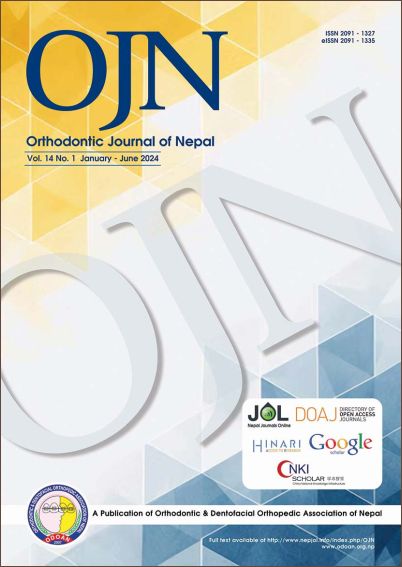Effect of Low-Level Laser Therapy (LLLT) after Piezocision on the Rate of Tooth Movement During En-Masse Retraction: A Prospective Clinical Study
DOI:
https://doi.org/10.3126/ojn.v14i1.58355Keywords:
RAP (Regional Acceleratory Phenomenon), OTM (Orthodontic Tooth Movement), LLLT (Low Level Laser TherapyAbstract
Background: With increasing awareness of facial aesthetics and the desire for an appealing smile, patients are demanding faster and better results than ever before in orthodontic treatment. This trend motivates orthodontists to engage in more research in the field of accelerated orthodontics to expedite treatment and satisfy individual preferences for aesthetics.
Aim and Objectives: To evaluate and compare the effects of sequential Piezocision, Piezocision followed by Low-Level Laser Therapy (LLLT), and conventional sliding mechanics during en-masse retraction.
Materials and Method: The study included 30 subjects with skeletal and dental Class I relationship who were treated orthodontically with four fist premolar extraction. They were randomly divided into three groups of 10 patients each. Group A was subjected to conventional sliding mechanics, Group B underwent sequential Piezocision, and Group C received Piezocision followed by LLLT for en-masse retraction. Study models were taken every month for three months to measure the distance between the contact points of the canine and second premolar on both sides.
Result: Statistically significant rates of space closure were observed in Group C, followed by Group B. The amount of space closure on right and left sides after 3 months of study period in Group C, Group B and Group A in descending order were 3.27 ± 0.16 mm and 3.29 ± 0.05 mm > 2.91 ± 0.17 mm and 2.91 ± 0.13 mm > 2.24 ± 0.25 mm and 2.29 ± 0.05 mm respectively.
Conclusion: LLLT further enhances the regional acceleratory phenomenon achieved with Piezocision, resulting in faster orthodontic tooth movement.
Downloads
Downloads
Published
How to Cite
Issue
Section
License
Copyright (c) 2024 Orthodontic & Dentofacial Orthopedic Association of Nepal

This work is licensed under a Creative Commons Attribution 4.0 International License.
Copyright © held by Orthodontic & Dentofacial Orthopedic Association of Nepal
- Copyright on any research article is transferred in full to the Orthodontic & Dentofacial Orthopedic Association of Nepal upon publication in the journal. The copyright transfer includes the right to reproduce and distribute the article in any form of reproduction (printing, electronic media or any other form).
- Articles in the Orthodontic Journal of Nepal are Open Access articles published under the Creative Commons CC BY License (https://creativecommons.org/licenses/by/4.0/)
- This license permits use, distribution and reproduction in any medium, provided the original work is properly cited.




